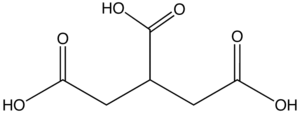Propane-1,2,3-tricarboxylic acid
 | |
| Names | |
|---|---|
| IUPAC name
Propane-1,2,3-tricarboxylic acid | |
| Other names
Tricarballylic acid, carballylic acid, 1,2,3-propanetricarboxylic acid, beta-carboxyglutaric acid | |
| Identifiers | |
| 99-14-9 | |
| 3D model (Jmol) | Interactive image |
| ChemSpider | 14220 |
| ECHA InfoCard | 100.002.485 |
| PubChem | 14925 |
| |
| |
| Properties | |
| C6H8O6 | |
| Molar mass | 176.12 g/mol |
| Appearance | colourless solid |
| Melting point | 156-161 |
| sl. in water | |
| Related compounds | |
| Related compounds |
citric acid |
| Except where otherwise noted, data are given for materials in their standard state (at 25 °C [77 °F], 100 kPa). | |
| | |
| Infobox references | |
Propane-1,2,3-tricarboxylic acid, also known as tricarballylic acid, carballylic acid, and beta-carboxyglutaric acid, is a tricarboxylic acid that has three carboxylic acid functional groups. The compound is an inhibitor of the enzyme aconitase and therefore interferes with the Krebs cycle.[1]
Esters of propane-1,2,3-tricarboxylic acid are found in natural products such as the mycotoxins fumonisin B1 and B2 and AAL toxin TA and in macrocyclic inhibitors of Ras farnesyl-protein transferase (FPTase) like actinoplanic acid.
It can be synthesized in two steps from fumaric acid.[2]
Mechanism of the inhibition of Aconitase
Aconitase normally catalyses, via Aconitic acid, the interconversion of citric acid into isocitric acid (see figure above). Propane-1,2,3-tricarboxylic acid is very suited to bind to aconitase as it only lacks the hydroxide group compourd to citric acid. On the other hand, as the hydroxide group is essential to proceed from citric acid to aconitic acid, the enzyme is not able to complete the reaction. The enzyme is stuck with a molecule it cannot get rid of.
References
- ↑ Russell, J. B., and N. Forsberg. 1986. Production of tricarballylic acid by rumen microorganisms and its potential toxicity in ruminant tissue metabolism. British Journal of Nutrition (1986), 56:153-162 56:153-162. doi:10.1079/BJN19860095
- ↑ H. T. Clarke; T. F. Murray (1941). "Tricarballylic Acid". Org. Synth.; Coll. Vol., 1, p. 523


